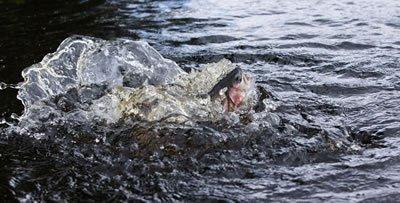Small Stillwater Tactics
by Peter Cockwill
It's the peak of the season on small stillwater fisheries with clouds of damsel flies, great buzzer hatches and stacks of pin fry. I love it now as the water is invariably dead clear and not yet too warm so the long daylight hours are perfect to find feeding fish.
A floating line with a leader at least 12 feet long is ideal to fish a damsel nymph pattern through the areas of the lake where there's lots of weed beds which are home to the naturals and where the Trout will be cruising on the lookout for food. Use a steady ‘figure eight' retrieve or long, slow strips and always pay attention for a fish following the fly. As soon as you see one following it pays to increase the retrieve speed to get the fish to commit to the take. There are scores of damsel patterns and, without doubt the number one pattern is the Blue Flash Damsel which works just about everywhere.
If the fishery has deep margins use a full length ‘slime' line or clear sink tip to keep the fly deeper on the retrieve and be sure to make the final lift a smooth progression so that a following fish will have to make a decision to take it or leave it. As soon as I see a following fish I am convinced I can catch it as I lift off to recast.

Try either a CDC winged pattern which sits half in and half out and is easy to watch as the dark CDC feather shows up well in the surface against the bright light of early morning or the fading light of evening. Don't expect a big splash, feeding fish are invariably close to the surface and all they need do is gently tip up to sip in the fly and cruise slowly on - be sure to keep an eye on your fly.
Nothing bigger than a size 12 hook and preferably just a 16 on a 3lb tippet will guarantee you a great fight from the average 2lb Trout and a nerve jangling time if you connect with a trophy fish. These lower light times and the use of a dry/emerger is often a great way to trap an unwary Brown Trout. The seemingly smarter Brown can be elusive in summer on many small waters during the peak of the day so choose an evening session if you can't get a full day.
I have to say that high summer is my favourite time of the year to indulge my love of selective trouting because now, during the day, the sun is at its peak and I can see really well into the clear water fisheries.
I use the smallest of weighted patterns and get a real buzz from watching a targeted Trout inhale the fly with the utmost confidence. Usually called ‘stalking' this style of catching Trout is very effective and you will get more pleasure by using the smaller simplistic patterns than casting heavy creations of fritz and marabou. The quality of Trout stocked in our fisheries is outstanding and yet each and every one is a different individual such that when I am hosting a club or corporate day I get to recognise some of them throughout the day and can work out tactics for guests to catch specific fish and that really is a fun occasion. Try it yourself and spend more time just observing the fish and keep casting time to a minimum. You sure will learn a lot more that way.
Hardy ProTeam member, Peter Cockwill has spent thirty years with Trout Fisherman magazine, written five books, owned his own fly shop and managed a fishery, Peter brings a wealth of diverse talent to the team.
Peter has been arranging foreign fishing trips for 25 years and always considers his trophy catch to be his IGFA World Fly Record for Arctic Grayling. Best known for his features on small stillwaters he is also an instructor, guide and fly tier with an enviable competition history and he will use his skills to enhance the Hardy brand.